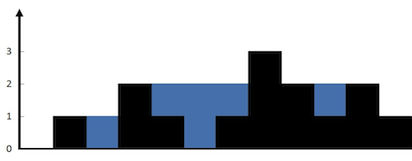Given n non-negative integers representing an elevation map where the width of each bar is 1, compute how much water it is able to trap after raining.

The above elevation map is represented by array [0,1,0,2,1,0,1,3,2,1,2,1]. In this case, 6 units of rain water (blue section) are being trapped. Thanks Marcos for contributing this image!
Example:
Input: [0,1,0,2,1,0,1,3,2,1,2,1] Output: 6
首先找到最高的bar,然后从左到这个最高的bar,依次计算面积;再从右到这个最高的bar,依次计算面积。时间复杂度n*2 = O(n)
class Solution { public int trap(int[] height) { int ret = 0; int curIndex = 0; //index of highest int topIndex = 0; for(int i = 1; i < height.length; i++){ if(height[i] > height[topIndex]) topIndex = i; } for(int i = 0; i < topIndex; i++){ if(height[i] > height[curIndex]){ curIndex = i; } else{ ret += (height[curIndex]-height[i]); } } curIndex = height.length-1; for(int i = height.length-2; i > topIndex; i--){ if(height[i] > height[curIndex]){ curIndex = i; } else{ ret += (height[curIndex]-height[i]); } } return ret; } }